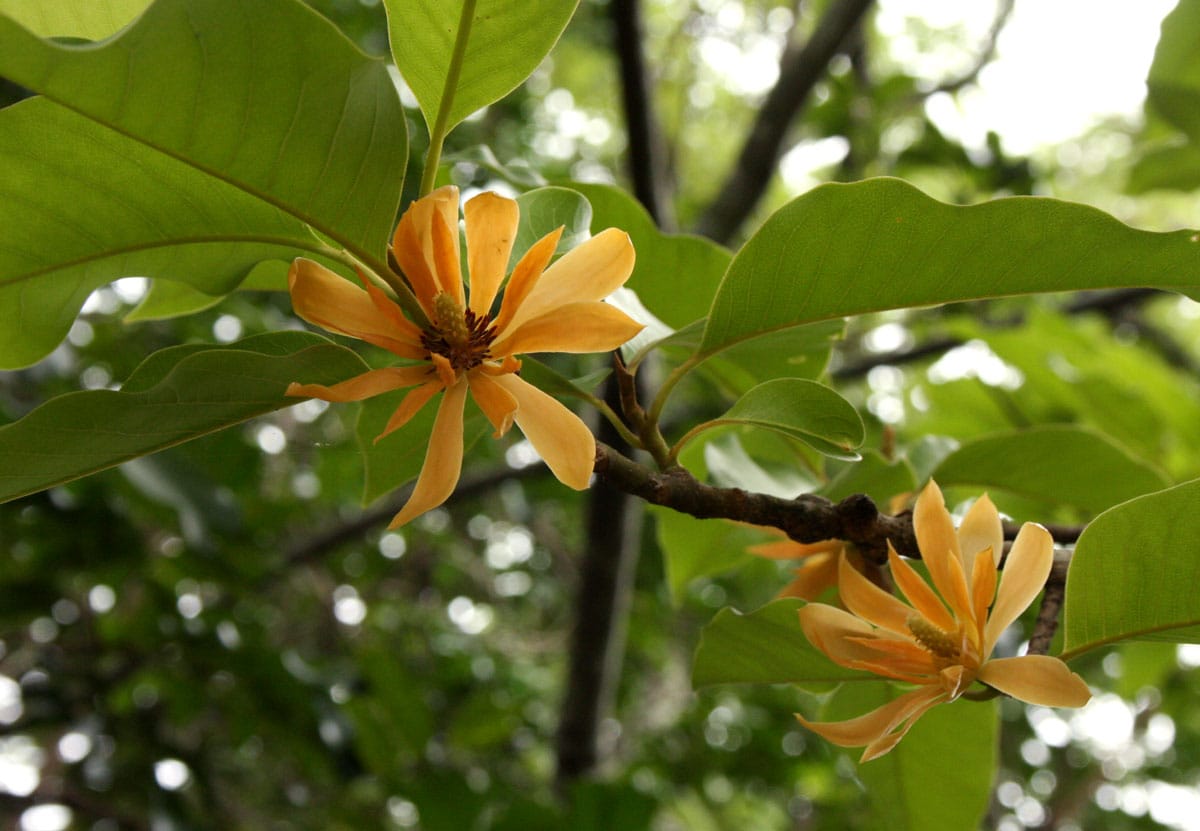The Champaca tree (*Magnolia champaca*) offers more than just visual appeal; its rich fragrance and cultural significance make it a true treasure. This comprehensive guide explores everything from growing and caring for your own Champaca tree to understanding its history, symbolism, and the fascinating nuances that distinguish it from other magnolias.
Experiencing the Aromatic Champaca
The champaca tree isn’t merely a tree; it’s a sensory journey. Its creamy-white and golden blossoms release a sweet, heady perfume that can transform any garden into a fragrant oasis. Native to the Indomalayan region, this tropical beauty, a member of the magnolia family, can reach impressive heights of up to 50 meters in its natural habitat, its branches forming a lush, umbrella-shaped crown.
Cultivating Your Own Champaca Oasis
Inviting a champaca tree into your garden is a rewarding experience. While generally low-maintenance, understanding its needs is key to its success.
Essential Care Tips
- Soil: Champacas prefer well-drained, slightly acidic soil, much like a comfortable bed for their roots. Adding compost can improve drainage and nutrient content. Loamy and sandy loam soils are also suitable, but avoid heavy clay, which can lead to waterlogged conditions detrimental to root health.
- Light: Dappled shade or bright, indirect light is ideal. While they appreciate sunlight, direct, scorching rays can be harmful. Morning sun is often preferred, offering gentle warmth without the intensity of midday heat.
- Water: Consistent watering, especially during dry periods, is essential. Feel the soil; when the top inch or two is dry, it’s time to water. Avoid both underwatering and overwatering, as champacas are drought-sensitive but also prone to root rot in excessively wet conditions. Aim for about an inch of water per week, adjusting based on rainfall and your local climate.
- Fertilizer: While not strictly required, a balanced, slow-release fertilizer applied monthly during the growing season (spring and summer) can encourage vigorous growth and abundant blooms.
- Pruning: Primarily to remove dead or diseased branches, pruning should be minimal. Light trimming after flowering can help maintain shape and promote new growth, but avoid heavy pruning which can disrupt the tree’s natural form. Deadheading (removing spent flowers) encourages further blooming.
Unveiling the Champaca’s Versatility
Beyond its beauty, the champaca tree offers a wealth of uses and benefits:
- Fragrance: The intensely fragrant flowers are a cornerstone of many perfumes and incense, often used in religious ceremonies.
- Timber: The durable champaca wood is suitable for various woodworking projects.
- Ornamental Value: Its lush foliage and fragrant blossoms make it a prized addition to gardens and landscapes.
- Cultural Significance: In South Asia, it’s associated with Buddhism, good fortune, and positive energy.
Exploring the World of Champaca Varieties
The champaca family is diverse. Magnolia champaca var. champaca (Huang lan) is renowned for its potent fragrance. Ongoing research continues to uncover new varieties and hybrids, each with its unique characteristics.
| Variety/Hybrid | Characteristics |
|---|---|
| Magnolia champaca var. champaca | Known as “Huang lan” in Chinese, this variety is celebrated for its exceptionally potent and sweet fragrance. |
| Other Varieties/Hybrids | Ongoing research continues to reveal a wider array of champaca varieties and hybrids, each with its distinct characteristics. |
Magnolia vs. Champaca: Unraveling the Aromatic Mystery
While all champacas are magnolias, not all magnolias are champacas. Magnolia champaca, often simply called “champaca,” possesses distinct features.
Key Distinctions
- Flower Placement: Champaca flowers grow along the stems, while most magnolias bloom at branch tips.
- Fragrance: Champaca boasts an intensely rich fragrance, more potent than many other magnolias. This characteristic aroma has earned it names like “joy perfume tree” and “yellow jade orchid tree,” and it’s a prized ingredient in high-end perfumes.
- Climate: Champacas thrive in tropical and subtropical regions, whereas magnolias have a wider range, including temperate zones.
- Uses: Champaca is used in traditional medicine and its timber is valued, while magnolias are primarily ornamental.
| Feature | Magnolia | Champaca (Magnolia champaca) |
|---|---|---|
| Flower Position | Primarily at branch tips | Along stems |
| Fragrance | Often fragrant | Intensely fragrant |
| Climate | Wide range, including temperate | Tropical and subtropical |
| Uses | Primarily ornamental | Perfume, medicine, timber |
The reclassification of champaca from Michelia champaca to Magnolia champaca reflects ongoing botanical research and phylogenetic analysis, enhancing our understanding of the evolutionary relationships within the Magnoliaceae family. This dynamic field continues to evolve, and future research may further refine our understanding.
How Big Do Champaca Trees Get?
Champaca tree size varies considerably. In their native Southeast Asian rainforests, they can reach a towering 164 feet (50 meters). Cultivated varieties are typically smaller, averaging around 30 feet (9 meters), with some compact cultivars like “Golden Champaka” reaching 15-20 feet, ideal for smaller gardens or containers.
Several factors influence a champaca tree’s size:
- Variety: Some are naturally smaller than others. “Golden Champaka” is known for its compact nature.
- Growing Conditions: Optimal sunlight, well-drained soil, and consistent watering contribute to healthier growth.
- Pruning: Regular trimming can maintain a smaller size.
Knowing the potential size is crucial for planning. Consider your available space and choose a variety that fits your needs. Callistemon viminalis the Weeping Bottlebrush, offers a different size and aesthetic for your garden.
Caring for Your Champaca Plant: A Deeper Dive
Nurturing a champaca involves providing the right environment and care:
Planting and Site Selection:
- Hardiness Zones: USDA zones 10-12.
- Soil: Well-draining loamy soil, sandy loam acceptable. Avoid heavy clay.
- Sunlight: Full sun to partial shade, preferably morning sun.
- Spacing: Ample space for mature size (potentially 40-50 feet tall, 20-25 feet spread).
Watering and Fertilizing:
- Watering: Consistent moisture is crucial, but avoid overwatering. At least 1 inch of water per week is a good starting point.
- Fertilizing: Balanced fertilizer monthly during the growing season.
Pruning and Maintenance:
- Pruning: After flowering, prune lightly to maintain shape and promote new growth.
- Deadheading: Remove spent flowers for continued blooming.
- Mulching: Apply mulch to retain moisture and suppress weeds.
Pest and Disease Control: Regularly inspect for pests and diseases. Early detection is key. If you’re fascinated by intricate patterns in nature, you might be interested in Choriaster granulatus, a species of starfish.
By following these guidelines and understanding the specific needs of your chosen variety, you can enjoy the enchanting beauty and fragrance of a champaca tree for years to come. Remember, every plant is unique. Don’t hesitate to adapt these tips based on your specific environment and the individual needs of your champaca.
- Discover Long Black Pepper: Flavor & Health Benefits - April 25, 2025
- Shocking Twists: The Grownup Review: Unreliable Narration - April 25, 2025
- A Quiet Place Book vs Movie: A Deep Dive - April 25, 2025

















2 thoughts on “The Enchanting Champaca Tree: A Complete Guide to Growing, Care, and Cultural Significance”
Comments are closed.